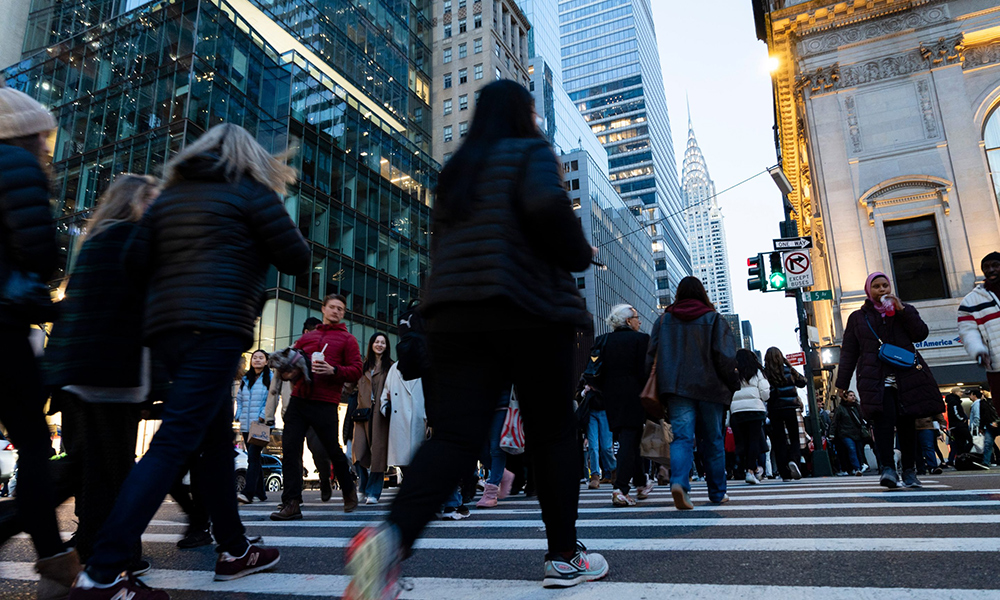
我们总是能从经济数据中看到一些信号。这些信号通常会体现美国的整体状况——哪些人表现出色,原因是什么。但现在这种情况并未出现。宏观和微观现实不同步的情况是前所未见的。严重经济失调已经到来。许多经济学家称,美国经济的客观表现良好,但也有许多人根本不认同这种观点。
媒体纷纷为强劲的经济增长和劳动力市场欢呼,但民意调查显示,大多数美国人对当前的经济形势深感悲观。尽管美国进行了数十年来最大幅度的加息,但GDP增长依旧强劲。通胀导致物价上涨,但人均个人消费却持续暴涨。我们现在所处的劳动力市场,是近期记忆中最火爆的劳动力市场,但各消费者群体和产品的借款人违约情况也在持续增多。
我们需要让各方面因素之间的差异逐渐缩小,而不是继续扩大,因此,在2024年,我们必须全面减少消费。事实上,有人可能会用“衰退”这个词来形容这种必要性。但透过更广泛的事实,我们会发现核心问题是,我们的消费远高于我们的工资收入。“经济衰退”或许听起来有些可怕,但GDP增速放缓或适度收缩,能够带来美国人渴望已久的东西:稳定性。
混杂的信号
在疫情期间,美国政府向系统中注入了大量资金。我们不应该对通货膨胀感到意外,因为货币供应增加40%通常都会影响物价。
刺激措施的后续影响是导致美国人减少了工作,尤其是接近退休年龄的年长上班族。与此同时,我们使用刺激政策发放的补助购买特斯拉(Tesla)汽车、Wayfair沙发和Pelotons(经济学家将它们称为“耐用品”),现在我们似乎不愿意改掉这种习惯。
高利率并没有帮助我们改变新的消费习惯,因为我们(尚)不需要太多信贷也能维持消费。刺激政策发放的过多现金在美国经济中流通,但许多美国人喜欢保留的额外缓冲现在已经基本消失。
与此同时,结构性用工荒问题正在恶化。在疫情爆发时,美国已经出现了劳动力供不应求的情况。许多年长的上班族在疫情结束后并没有重新回到劳动力队伍,这加剧了用工荒问题,目前的职位空缺多达约900万个。
相对于疫情之前的数据,收入增长并没有跟上我们疯狂消费的速度。劳动力增长缓慢,而且消费物价上涨和刺激补助持续缓慢减少的双重阻力,抵消了火爆的劳动力市场上出现的任何工资增长。
我们无需回顾太久远的历史,也能知道这些趋势持续下去的后果。消费和收入之间的日益失衡,使我们的储蓄率降至65年以来的最低点。唯一一个与当前类似的时期是全球金融危机之后。当时美国财政不稳定的根本原因,是10%的失业率带来的压力。而今天的情况是我们一手造成的后果,因为我们的消费超出了我们的能力。
后退半步可能是成功软着陆的关键
美国人的消费,总体上超过了收入和储蓄,这导致借款违约水平提高。GDP增长速度超出了我们的承受能力。我们需要让GDP稍微降温。一点宏观层面的焦虑,可以让消费者更好地管理个人财务,恢复更健康、更可持续的消费。
只要我们为短期经济降温创造条件,消费(和生产)疲软,不太可能导致目前供应紧张的劳动力市场出现大规模失业。它更有可能使当前严重失衡的劳动力市场趋于平衡。当然,对于任何经济不景气的迹象,政府几乎一定会采取降息进行应对,这将有利于所有消费者的财务健康。
我们一直被教导,对经济而言,越多越好。这或许是正确的,但快速增长无法一直持续下去,也无法公平分配。未来几周,当专家们辩论如何解读最近的节日季消费数据时,请注意,后退半步可能是成功软着陆的关键。如果我们能做到这一点,我们就会发现自己幸运地成了更好的经济环境的受益者。(财富中文网)
本文作者桑杰·达塔为AI借贷平台Upstart的首席财务官。
Fortune.com上发表的评论文章中表达的观点,仅代表作者本人的观点,不能代表《财富》杂志的观点和立场。
翻译:刘进龙
审校:汪皓
我们总是能从经济数据中看到一些信号。这些信号通常会体现美国的整体状况——哪些人表现出色,原因是什么。但现在这种情况并未出现。宏观和微观现实不同步的情况是前所未见的。严重经济失调已经到来。许多经济学家称,美国经济的客观表现良好,但也有许多人根本不认同这种观点。
媒体纷纷为强劲的经济增长和劳动力市场欢呼,但民意调查显示,大多数美国人对当前的经济形势深感悲观。尽管美国进行了数十年来最大幅度的加息,但GDP增长依旧强劲。通胀导致物价上涨,但人均个人消费却持续暴涨。我们现在所处的劳动力市场,是近期记忆中最火爆的劳动力市场,但各消费者群体和产品的借款人违约情况也在持续增多。
我们需要让各方面因素之间的差异逐渐缩小,而不是继续扩大,因此,在2024年,我们必须全面减少消费。事实上,有人可能会用“衰退”这个词来形容这种必要性。但透过更广泛的事实,我们会发现核心问题是,我们的消费远高于我们的工资收入。“经济衰退”或许听起来有些可怕,但GDP增速放缓或适度收缩,能够带来美国人渴望已久的东西:稳定性。
混杂的信号
在疫情期间,美国政府向系统中注入了大量资金。我们不应该对通货膨胀感到意外,因为货币供应增加40%通常都会影响物价。
刺激措施的后续影响是导致美国人减少了工作,尤其是接近退休年龄的年长上班族。与此同时,我们使用刺激政策发放的补助购买特斯拉(Tesla)汽车、Wayfair沙发和Pelotons(经济学家将它们称为“耐用品”),现在我们似乎不愿意改掉这种习惯。
高利率并没有帮助我们改变新的消费习惯,因为我们(尚)不需要太多信贷也能维持消费。刺激政策发放的过多现金在美国经济中流通,但许多美国人喜欢保留的额外缓冲现在已经基本消失。
与此同时,结构性用工荒问题正在恶化。在疫情爆发时,美国已经出现了劳动力供不应求的情况。许多年长的上班族在疫情结束后并没有重新回到劳动力队伍,这加剧了用工荒问题,目前的职位空缺多达约900万个。
相对于疫情之前的数据,收入增长并没有跟上我们疯狂消费的速度。劳动力增长缓慢,而且消费物价上涨和刺激补助持续缓慢减少的双重阻力,抵消了火爆的劳动力市场上出现的任何工资增长。
我们无需回顾太久远的历史,也能知道这些趋势持续下去的后果。消费和收入之间的日益失衡,使我们的储蓄率降至65年以来的最低点。唯一一个与当前类似的时期是全球金融危机之后。当时美国财政不稳定的根本原因,是10%的失业率带来的压力。而今天的情况是我们一手造成的后果,因为我们的消费超出了我们的能力。
后退半步可能是成功软着陆的关键
美国人的消费,总体上超过了收入和储蓄,这导致借款违约水平提高。GDP增长速度超出了我们的承受能力。我们需要让GDP稍微降温。一点宏观层面的焦虑,可以让消费者更好地管理个人财务,恢复更健康、更可持续的消费。
只要我们为短期经济降温创造条件,消费(和生产)疲软,不太可能导致目前供应紧张的劳动力市场出现大规模失业。它更有可能使当前严重失衡的劳动力市场趋于平衡。当然,对于任何经济不景气的迹象,政府几乎一定会采取降息进行应对,这将有利于所有消费者的财务健康。
我们一直被教导,对经济而言,越多越好。这或许是正确的,但快速增长无法一直持续下去,也无法公平分配。未来几周,当专家们辩论如何解读最近的节日季消费数据时,请注意,后退半步可能是成功软着陆的关键。如果我们能做到这一点,我们就会发现自己幸运地成了更好的经济环境的受益者。(财富中文网)
本文作者桑杰·达塔为AI借贷平台Upstart的首席财务官。
Fortune.com上发表的评论文章中表达的观点,仅代表作者本人的观点,不能代表《财富》杂志的观点和立场。
翻译:刘进龙
审校:汪皓
Economic data is always offering us signals. Often, these signals tell a cohesive story about America–who is doing well and why. But today, that’s not happening. The macro and micro realities have never been more out of sync. Welcome to the Great Economic Mismatch. Many economists are saying that America is objectively doing great–but many others fundamentally disagree.
Headlines are trumpeting robust economic growth and the strength of the labor market, but polls show that most Americans are deeply pessimistic about today’s economy. GDP growth remains strong, despite interest rates increasing at their steepest in decades. Inflation has caused prices to rise, but per capita personal consumption continues to soar. We are in the midst of the hottest labor market in recent memory, but borrower defaults have been on the rise across all consumer segments and products.
We need these paths to converge, not grow further apart, which is why, in 2024, we have to reduce our consumption as a country. Indeed, some might use the word “recession” to describe this need. Yet viewed through the broader lens of the facts at play, the central problem is that we are consuming too much stuff relative to our paychecks. The “r-word” may be scary, but a slowdown or mild contraction of GDP may offer something Americans crave: Stability.
Mixed signals
During the pandemic, the government injected a massive amount of money into the system. Inflation shouldn’t have come as a surprise–a 40% increase in the money supply will usually impact prices.
The subsequent windfall of the stimulus induced Americans to work less–particularly older workers closer to retirement. Meanwhile, we used stimulus money to buy things like Teslas, Wayfair sofas, and Pelotons (what economists call “durable goods”), a habit we now seem loath to abandon.
High interest rates have done little to dull our new spending habits–because we haven’t needed much credit (yet) to sustain them. The excess cash from the stimulus has lingered in the economy, but that extra cushion so many Americans enjoyed is now largely gone.
At the same time, structural labor shortages were accelerated. By the time the pandemic rolled around, America was already in a position of needing more workers than it had. When many older workers simply did not return from lockdown, it exacerbated our labor shortage, leaving us today with almost 9 million unfilled jobs.
Relative to pre-pandemic numbers, income growth has not kept up with our torrid pace of consumption. Workforce gains have been lethargic, and any wage gains from the hot labor market have been offset by the combined headwinds of rising consumer prices and stimulus continuing to slowly drain from the economy.
We don’t need to look back far to see what happens if these trends hold. The growing imbalance between our consumption and our income has strained savings rates to their lowest point in 65 years. The only other prior comparable period was in the wake of the Global Financial Crisis. Back then, the root cause of our precarious fiscal health was the stress of 10% unemployment. Today, it is self-wrought from consuming beyond our means.
One half-step backward may be the key to sticking a soft landing
Overall, Americans have consumed much more than we have been earning and saving, contributing to increasing levels of default on what we owe. GDP growth is running hotter than we can handle. We need a balm to cool it off a touch. A spoonful of macro anxiety could convince the economy’s consumers to get their fiscal house into better shape and return to a healthier and more sustainable level of consumption.
By creating the conditions for brief economic cooling, the softening of consumption (and therefore production) is unlikely to tip the current supply-constrained labor market into significant unemployment. It is more likely to nudge the current severe worker imbalance closer to equilibrium. And of course, the government will almost certainly respond to any whiff of economic malaise with lower interest rates, which will benefit the fiscal health of all consumers.
We’ve been taught that more is almost always better with the economy. While that can be true, fast growth is not always sustainable or equitably distributed. In the weeks ahead, when the pundits are debating how to interpret the latest holiday spending numbers, keep in mind that one half-step backward may be the key to sticking a soft landing. If we can do that, we may find ourselves the fortunate beneficiaries of a better economy for everyone.
Sanjay Datta is the CFO of Upstart, the AI lending marketplace.
The opinions expressed in Fortune.com commentary pieces are solely the views of their authors and do not necessarily reflect the opinions and beliefs of Fortune.






